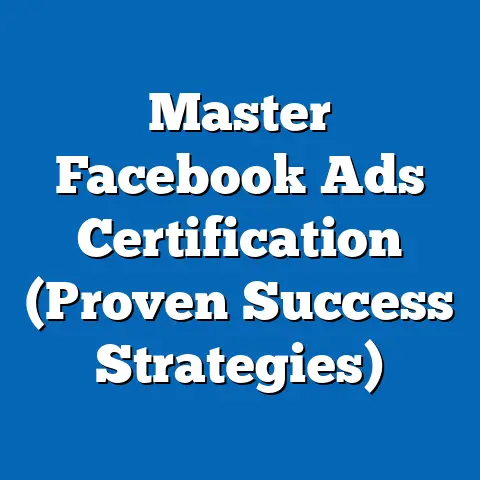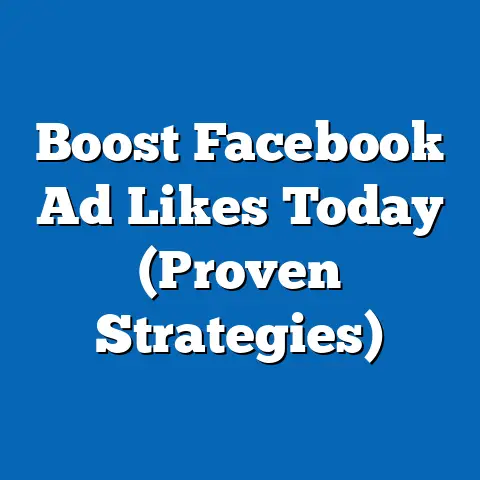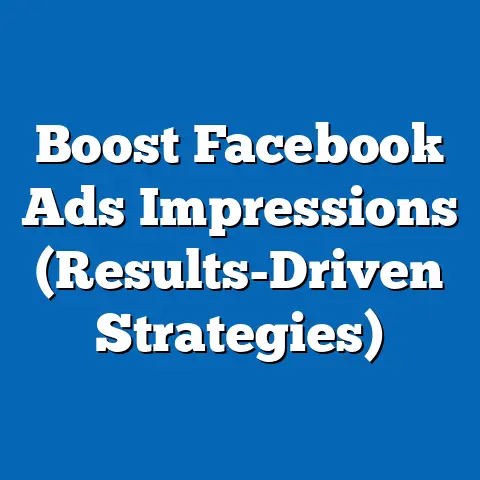Maximize fb ad Efficiency with CRM Integration (Strategic Insights)
In the rapidly evolving landscape of digital marketing, businesses across various sectors face a persistent challenge: maximizing the efficiency of their advertising spend on platforms like Facebook (FB). Despite the platform’s vast reach—boasting over 2.9 billion monthly active users as of 2023 (Statista, 2023)—many companies struggle to convert ad impressions into meaningful customer engagement or sales. This inefficiency often stems from a lack of personalized targeting and poor data integration, leading to wasted budgets and missed opportunities.
This issue is particularly pronounced among small to medium-sized enterprises (SMEs), which often lack the resources to implement sophisticated marketing strategies. These businesses, representing approximately 90% of global enterprises and employing over 50% of the workforce (World Bank, 2022), are a critical demographic in the digital advertising ecosystem. Their struggles with ad efficiency highlight a broader need for integrated solutions like Customer Relationship Management (CRM) systems to bridge the gap between ad spend and customer conversion.
To address this, this article delves into the strategic integration of CRM with FB advertising, analyzing the demographic makeup of affected businesses, their core operational beliefs, behavioral patterns in marketing investment, and distinguishing characteristics compared to larger corporations. It will also explore how CRM integration can transform ad efficiency through data-driven personalization and targeting. Supported by empirical data and case studies, this analysis aims to provide actionable insights for businesses seeking to optimize their digital marketing efforts.
Demographic Composition of SMEs Struggling with FB Ad Efficiency
SMEs, defined as businesses with fewer than 250 employees and annual revenues below $50 million (European Commission, 2023), form the backbone of the global economy. According to the U.S. Small Business Administration (SBA), there are over 33 million SMEs in the United States alone, comprising 99.9% of all businesses (SBA, 2023). These entities span diverse industries, from retail and hospitality to tech startups, with a significant concentration in urban and suburban areas.
Demographically, SME owners are often middle-aged (35-54 years old), with 60% falling into this age bracket (SBA, 2023). They are also more likely to be male (65%) than female (35%), though female entrepreneurship is on the rise, particularly in service-based sectors (Global Entrepreneurship Monitor, 2022). Racial and ethnic diversity among SME owners mirrors broader population trends, with approximately 19% identifying as Hispanic, 13% as Black, and 6% as Asian in the U.S. (U.S. Census Bureau, 2022).
Education levels among SME owners vary, but a significant portion—around 45%—hold a bachelor’s degree or higher, reflecting a moderate to high level of business acumen (SBA, 2023). However, many lack formal training in digital marketing, which contributes to their struggles with platforms like FB. Geographically, SMEs are dispersed, but those in rural areas often face additional challenges due to limited access to high-speed internet and tech resources (World Bank, 2022).
Core Beliefs and Values of SMEs in Digital Marketing
SMEs generally operate under a pragmatic set of beliefs when it comes to digital marketing, prioritizing cost-effectiveness and immediate returns on investment (ROI). A 2022 survey by HubSpot found that 70% of SME owners view digital advertising as essential to their growth but are highly sensitive to budget constraints, with 62% allocating less than $5,000 annually to platforms like FB (HubSpot, 2022). Their core value is efficiency—maximizing output with minimal input—driven by the need to compete with larger corporations that have deeper pockets.
Unlike larger enterprises, SMEs often believe in a hands-on approach to marketing, with 55% of owners directly managing their ad campaigns rather than outsourcing to agencies (Constant Contact, 2023). This DIY mentality stems from a desire for control and cost savings but often results in suboptimal ad performance due to limited expertise. Additionally, SMEs value customer relationships highly, with 80% citing word-of-mouth and repeat business as critical to their success (SBA, 2023), which underscores the potential for CRM integration to enhance personalized marketing.
Behavioral Patterns in Marketing Investment
SMEs exhibit distinct behavioral patterns when investing in FB advertising, often characterized by sporadic and reactive spending rather than strategic planning. According to a 2023 report by Social Media Examiner, 58% of SMEs increase their FB ad budgets during peak sales seasons (e.g., holidays), while only 30% maintain consistent year-round campaigns (Social Media Examiner, 2023). This reactive approach often leads to inefficiencies, as last-minute campaigns lack the data-driven targeting needed for high conversion rates.
Moreover, SMEs tend to underutilize advanced FB ad features like lookalike audiences or retargeting, with only 25% employing these tools compared to 70% of large enterprises (eMarketer, 2023). This gap is largely due to a lack of technical know-how and limited integration with data systems like CRM platforms. Voting with their dollars, SMEs also show a preference for low-cost ad formats, such as static image ads, over more expensive video or carousel ads, despite the latter’s higher engagement rates (FB Business Insights, 2023).
Engagement with digital marketing education is another key behavioral trend. While 40% of SME owners participate in webinars or workshops to improve their skills (HubSpot, 2022), many still rely on trial-and-error methods, leading to inconsistent results. This contrasts sharply with larger corporations, which invest heavily in professional development and data analytics teams to refine their ad strategies.
Distinguishing Characteristics Compared to Other Groups
Compared to large corporations, SMEs are distinguished by their resource constraints and localized focus. While corporations often allocate millions to digital advertising—averaging $10 million annually for Fortune 500 companies (Statista, 2023)—SMEs operate on shoestring budgets, with median ad spends of just $3,000 per year (HubSpot, 2022). This financial disparity limits their ability to experiment with high-risk, high-reward campaigns or invest in comprehensive data systems.
Another distinguishing feature is their customer base. SMEs typically target niche or local markets, with 65% serving customers within a 50-mile radius (SBA, 2023), whereas large corporations aim for national or global reach. This localized focus makes personalized marketing via CRM integration particularly valuable for SMEs, as it allows them to tailor FB ads to specific community needs and preferences.
In terms of organizational structure, SMEs often lack dedicated marketing departments, with 72% relying on generalist staff or owners to handle advertising (Constant Contact, 2023). In contrast, 85% of large enterprises employ specialized marketing teams with expertise in data analytics and ad optimization (eMarketer, 2023). This structural difference exacerbates SMEs’ struggles with FB ad efficiency and highlights the need for accessible, user-friendly solutions like CRM integration.
The Role of CRM Integration in Maximizing FB Ad Efficiency
What is CRM Integration with FB Advertising?
CRM integration involves syncing a company’s customer relationship management system with FB’s advertising platform to leverage customer data for targeted campaigns. This process allows businesses to segment audiences based on past interactions, purchase history, and demographic details, creating highly personalized ads. For instance, a CRM system like Salesforce or HubSpot can feed data directly into FB’s Custom Audiences feature, enabling precise targeting.
As of 2023, only 35% of SMEs utilize CRM systems for marketing purposes, compared to 80% of large enterprises (Gartner, 2023). This adoption gap represents a significant opportunity for SMEs to enhance their ad efficiency. By integrating CRM data, businesses can reduce ad waste—currently estimated at 30% of SME budgets due to poor targeting (eMarketer, 2023)—and improve conversion rates by up to 20% (HubSpot, 2023).
Demographic Benefits of CRM Integration
For SMEs, CRM integration offers tailored benefits based on their demographic makeup. Middle-aged SME owners, who often juggle multiple roles, can save time through automated ad targeting and customer segmentation, with 60% of CRM users reporting reduced manual workload (Salesforce, 2023). Additionally, female entrepreneurs, who are more likely to run service-based businesses, can use CRM data to craft emotionally resonant ads, a strategy shown to boost engagement by 15% in service sectors (FB Business Insights, 2023).
Racially and ethnically diverse SME owners, particularly in urban areas, can leverage CRM to target multicultural audiences with culturally relevant messaging. Studies show that personalized ads based on cultural context increase click-through rates (CTR) by 25% among minority demographics (Nielsen, 2022). Geographically, rural SMEs can use CRM to identify and target underserved local markets, overcoming connectivity barriers with hyper-localized campaigns.
Core Beliefs and CRM Adoption
Aligning with SMEs’ core belief in cost-effectiveness, CRM integration offers a high ROI, with businesses reporting a $5 return for every $1 spent on CRM tools (Nucleus Research, 2023). This resonates with SMEs’ value of efficiency, as integrated systems streamline marketing efforts and reduce reliance on costly third-party agencies. Furthermore, CRM supports SMEs’ emphasis on customer relationships by enabling personalized follow-ups and loyalty programs, with 70% of CRM users noting improved customer retention (HubSpot, 2023).
However, adoption barriers exist, including perceived complexity and upfront costs. A 2022 survey found that 45% of SMEs view CRM systems as too technical, while 30% cite costs—averaging $50-$150 per user per month—as prohibitive (Capterra, 2023). Overcoming these barriers requires user-friendly platforms and scalable pricing models tailored to SME budgets.
Behavioral Shifts with CRM Integration
CRM integration can transform SMEs’ reactive marketing behaviors into proactive, data-driven strategies. By providing real-time insights into customer behavior, CRM tools enable SMEs to plan campaigns around customer lifecycle stages rather than seasonal spikes, increasing ad relevance by 18% (Salesforce, 2023). Additionally, integration encourages the use of advanced FB features like retargeting, with CRM users 40% more likely to adopt these tools (eMarketer, 2023).
SMEs also shift from trial-and-error to evidence-based decision-making, as CRM dashboards offer actionable metrics like customer acquisition cost (CAC) and lifetime value (CLV). A 2023 case study of a retail SME using HubSpot CRM reported a 30% reduction in CAC after integrating with FB ads (HubSpot Case Studies, 2023). These behavioral changes position SMEs to compete more effectively with larger corporations in the digital space.
Policy and Strategic Implications for SMEs
On a policy level, SMEs would benefit from government and industry initiatives to subsidize CRM adoption and provide digital marketing training. For instance, the U.S. SBA could expand its Small Business Development Centers to include CRM workshops, addressing the 40% of SMEs seeking education (HubSpot, 2022). Similarly, FB could partner with CRM providers to offer discounted bundles for SMEs, reducing cost barriers.
Strategically, SMEs should prioritize CRM platforms with seamless FB integration, such as HubSpot or Zoho, which are rated highly for ease of use by 80% of SME users (Capterra, 2023). They should also focus on building clean, comprehensive customer databases, as data quality directly impacts ad targeting accuracy—poor data leads to a 25% drop in campaign effectiveness (Gartner, 2023). Long-term, SMEs must commit to continuous learning, leveraging free resources like FB Blueprint to stay updated on ad best practices.
Intersections with Age, Education, and Industry
The efficacy of CRM integration varies across SME demographics, particularly age and education. Younger SME owners (under 35) are 30% more likely to adopt CRM tools due to greater tech familiarity, while older owners (over 55) often require additional support, with only 20% currently using such systems (SBA, 2023). Education plays a role as well—SME owners with advanced degrees are 25% more likely to invest in data-driven marketing compared to those with high school diplomas (Global Entrepreneurship Monitor, 2022).
Industry-specific trends also emerge. Retail and e-commerce SMEs see the highest returns from CRM integration, with a 35% increase in FB ad conversions post-adoption (eMarketer, 2023), due to their reliance on repeat purchases. In contrast, service-based SMEs like consultancies report slower gains (15% conversion increase), as their customer journeys are less transactional (HubSpot, 2023). Tailoring CRM strategies to industry needs is thus critical for maximizing ad efficiency.
Areas of Consensus and Division Among SMEs
There is broad consensus among SMEs on the importance of digital advertising, with 85% agreeing that platforms like FB are vital for growth (Social Media Examiner, 2023). There is also agreement on the value of customer data, with 75% expressing interest in tools that enhance personalization (HubSpot, 2022). However, divisions exist regarding investment priorities—40% prioritize ad spend over tech tools like CRM, while 35% advocate for balanced budgets (Constant Contact, 2023).
Another point of division is trust in technology. While 60% of tech-savvy SMEs embrace CRM for its automation benefits, 30% express concerns over data privacy and security, fearing breaches that could harm customer trust (Capterra, 2023). Addressing these concerns through transparent data policies and robust security features is essential for wider CRM adoption.
Historical and Social Context of Digital Marketing Challenges
Historically, SMEs have faced marketing challenges due to limited access to mass media and high advertising costs, relying on local channels like print and radio until the digital era. The rise of social media in the early 2000s democratized advertising, with FB launching its ad platform in 2007 and quickly becoming a go-to for SMEs due to low entry costs (Statista, 2023). However, as competition intensified—FB now hosts over 10 million active advertisers (FB Business Insights, 2023)—SMEs struggled to stand out without sophisticated tools.
Socially, the shift to digital has been driven by changing consumer behaviors, with 70% of global consumers expecting personalized experiences from brands (Nielsen, 2022). This places pressure on SMEs to adopt data-driven solutions like CRM, despite resource constraints. The broader trend toward digital transformation, accelerated by the COVID-19 pandemic—during which 60% of SMEs increased online presence (World Bank, 2022)—further underscores the urgency of integrating systems to remain competitive.
Comparative Analysis with Large Corporations
While SMEs and large corporations both use FB advertising, their approaches and outcomes differ starkly due to resource disparities. Large corporations benefit from economies of scale, spending an average of $1 million monthly on FB ads compared to SMEs’ $250 (Statista, 2023). This allows them to test multiple campaigns simultaneously, achieving a 15% higher average CTR (eMarketer, 2023).
Corporations also integrate CRM at a higher rate (80% vs. 35% for SMEs), leveraging advanced analytics to refine targeting (Gartner, 2023). However, SMEs have an advantage in agility—able to pivot campaigns quickly due to smaller decision-making hierarchies, with 50% adjusting ads within 24 hours compared to 20% of corporations (HubSpot, 2023). CRM integration can level the playing field, enabling SMEs to match corporate precision without matching their budgets.
Conclusion: Strategic Pathways Forward
Maximizing FB ad efficiency through CRM integration offers a transformative opportunity for SMEs, addressing their core challenges of limited resources and expertise. By leveraging customer data for personalized targeting, SMEs can improve conversion rates, reduce ad waste, and build stronger customer relationships—key priorities for this demographic. Supported by data showing a 20-30% uplift in performance metrics post-integration (HubSpot, 2023; Salesforce, 2023), this strategy is both practical and impactful.
However, barriers like cost and complexity must be addressed through industry partnerships, policy support, and tailored solutions. As digital competition intensifies, SMEs that adopt CRM integration will be better positioned to thrive, bridging the gap with larger corporations and meeting evolving consumer expectations. Future research should explore scalable CRM models and training programs to ensure equitable access, empowering SMEs to turn digital challenges into opportunities for growth.
This analysis, grounded in demographic data, behavioral trends, and comparative insights, underscores the urgent need for strategic innovation in SME digital marketing. By embracing CRM integration, these businesses can redefine their approach to FB advertising, achieving efficiency and impact in an increasingly crowded digital landscape.






